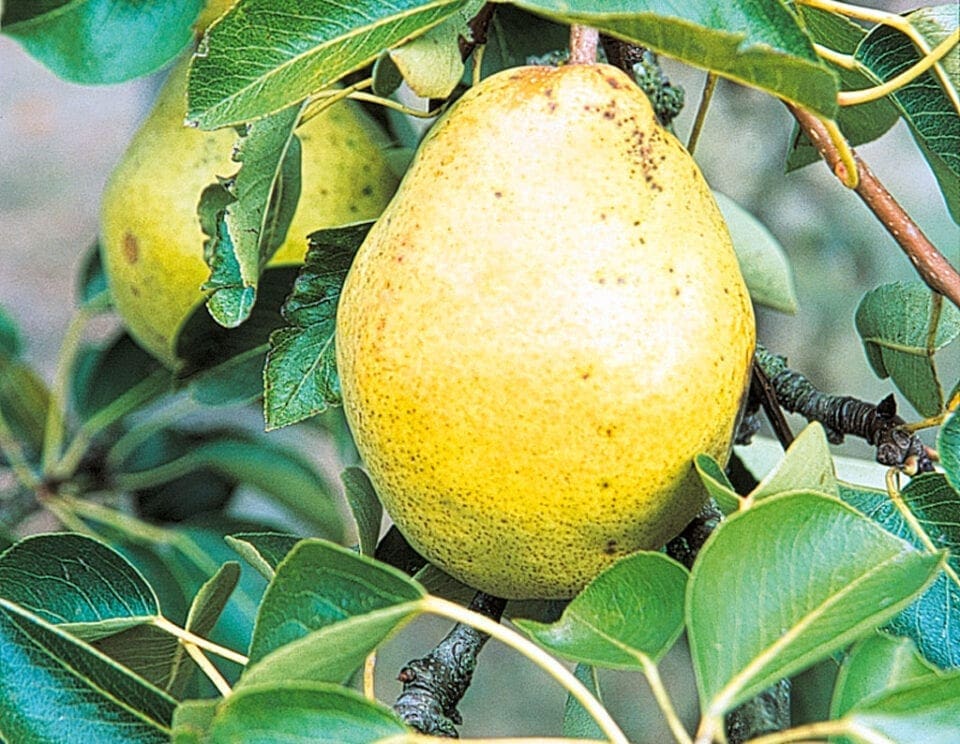Pears are a very popular fruit in our supermarkets, but not the easiest to grow well in our gardens. This is for two main reasons – firstly, like plums they happen to flower when frosts are still common and the entire crop can be wiped out by a few cold nights. Secondly, depending on the variety, there is often a very short time when the fruit is in prime condition for eating.
However, the taste of fresh picked fruit is such that many gardeners forgive them these few faults and persevere. Certainly, given the right conditions, pears will thrive and crop heavily in most seasons.
If you live in the north of the UK or garden on an exposed site, it is best to grow pears as a fan or cordon against a warm south or west-facing wall or fence.
Pear Varieties
Pears have been grown for many centuries and as a result lots of varieties have been bred, giving us a wide choice today.
The main groups are culinary (cooking) and dessert (eating), although many dessert pears can in fact be cooked or used raw in puddings.
There are also the rather more rare perry pears used for making a fine alcoholic drink and tonic, but these are not really suitable for smaller gardens. Among the most popular varieties of pear are:
- ‘Beth’
An early pear cropping in September. Not self-fertile. - ‘Conference‘
The most popular variety and partly self-fertile. - ‘Concorde’
A late variety cropping in October/November. - ‘Williams’ Bon Chretien’
Great flavour. Crops in September, but does not store well. Both ‘Beth’ and ‘Conference’ will pollinate it.

Growing Pears
Follow the planting and training advice given for apples and you won’t go far wrong. However, pears are rather fussier than apples when it comes to site.
The very early flowering means that it is more important to find a sheltered spot, especially when growing bush trees in the open. If this is not possible, stick to trained types such as cordons, fans and espaliers, which can be grown against a warm wall. They do have the advantage of tolerating heavier soils than apples, but dislike chalky conditions.
Choose a reasonably free-draining, moisture retentive soil and when planting make sure that the graft union is at least 13cm (5in) above the surface to prevent the fruiting wood from rooting into the soil and bypassing the roots.
When the plants are flowering, keep some fleece handy to cover the flowers that can be reached easily – wall-trained trees can sometimes be covered completely with a sheet suspended over the top, but be sure to uncover during the day when insects are flying.
Mulch each year in the spring after applying a general fertiliser. If crops are heavy, it may be necessary to thin the fruit to improve the quality of the remainder.
Harvesting Pears
Pears should be harvested when nearly ripe, since if left to become overripe they won’t store very well. Most tend to turn from a very acid green to a slightly lighter hue when ready for picking and some acquire a rosy blush, but colour is not always a good guide.
To pick simply lift and gently twist; if they come off without resistance they are ready. Take great care not to bruise the fruit and if you intend to store them, lay them out in a single layer in a paper-lined tray. Place somewhere cool and dark.
Scrumptious recipes for your homegrown pears
More grow guides
For more growing tips and guides, you should subscribe to Kitchen Garden – you’ll receive free seeds with every single issue too!





